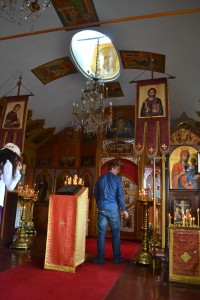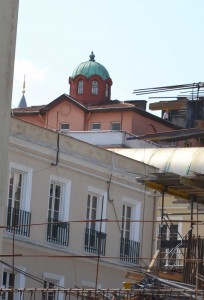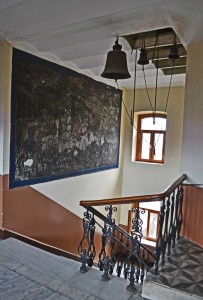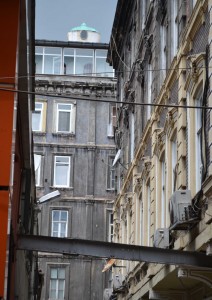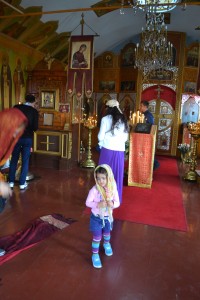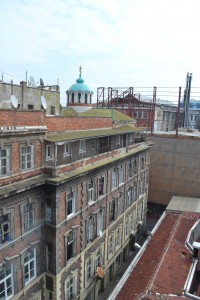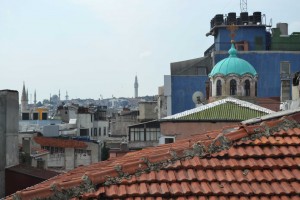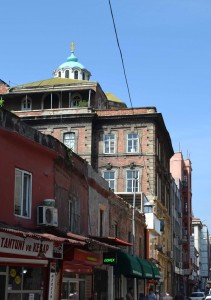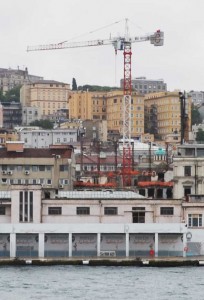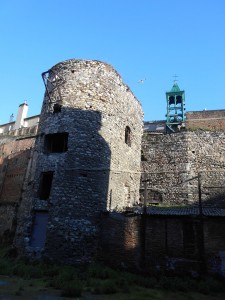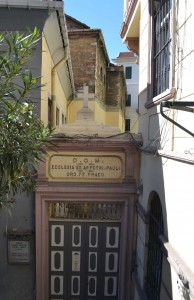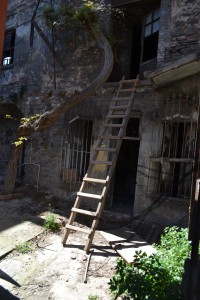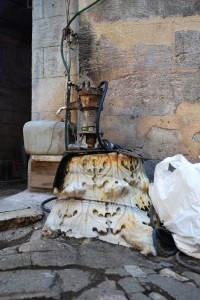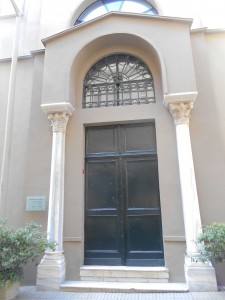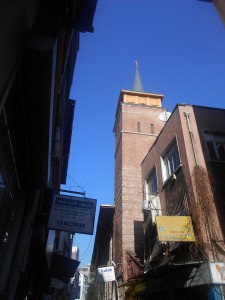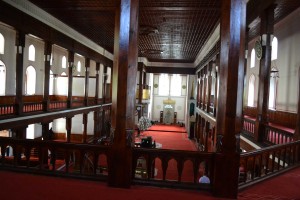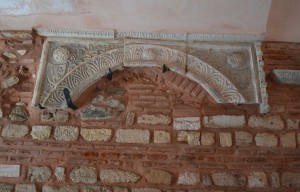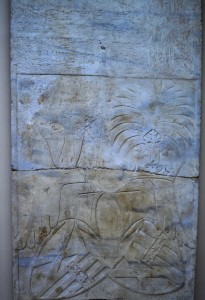Within 100 metres of each other, on top of the large warehouses in the Karaköy area, perch the domes of four Russian chapels – dedicated respectively to St Panteleimon (41.024749,28.978425), the prophet Elias (41.024447,28.97806), St Andrew (41.024613,28.978785), and the Holy Trinity (41.024787,28.979037). These were built between 1870 and 1880 to cater for Russian pilgrims breaking their sea journeys on the way to Mount Athos, or sometimes Jerusalem. There were dormitory rooms for the pilgrims in the buildings beneath the churches. The Holy Trinity chapel is now abandoned, although the dome is in surprisingly good repair. St Panteleimon is still staffed but is damp and peeling. Aya İliyas (The Chapel of the Prophet Elias/Elijah) has extensive frescoes painted in about 1900 by artists from Mt Athos. These are now looking fairly awful because of damp and lack of money for maintenance. There was a service held here in 2013. St Andrew had a restoration in preparation for a service of major importance held in 2011.
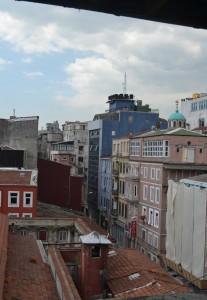
Church of the Prophet Elias from the balcony of the Church of St Andrew. Aziz Nikola in the foreground.
There are very good reasons for these recent one-off celebrations of mass. There is only one priest associated with the four Karaköy Russian churches. He is very old but has enormous energy. I met him in May 2014 and was impressed with the fighting spirit that he shows on behalf of his church (St Panteleimon). The community has called on the Russian Orthodox patriarchate to supply more priests. However these churches, despite being Orthodox and serving a Russian community, are not really Russian Orthodox. During the heyday of the churches, inevitably coinciding with the influx of Christians from the new Soviet Union just after the 1917 revolution, the churches’ links with the struggling Russian Orthodox Church dwindled. The churches came under the jurisdiction of the Mt Athos monasteries that provided their raison d’etre. These monasteries are, in turn, administered by the Greek Patriarchate in Constantinople.
The value of real estate in Karaköy is rising fast. The hans are not profitable. Until recently, they have been classified as commercial buildings. The contract for the development of Galataport, the reconstruction of the waterside area in Karaköy, is worth an enormous amount of money. There is no bar to demolition by developers of a building zoned as commercial. This explains the importance of services held in the churches of St Andrew and the Prophet Elijah in the last few years. If the churches can be shown to be active places of worship, there is a possibility, a very small possibility, of the buildings being saved. The Greek Patriarchate provided personnel to conduct the services. At the moment, the churches of St Andrew and the Prophet Elijah are in the best condition that they have been for over forty years. They are still permanently locked and it seems most unlikely that they will survive development that carries a financial incentive approaching a billion US dollars.
For now, St Panteleimon is the only church open for regular Sunday worship. Catch it now. In fact, turn up with vast numbers of your friends every Sunday for the foreseeable future. That may be the only way to give the survival of this fragile piece of Russo-Turco-Greek history any chance.

Posted June 28, 2014 Posted by Adam in Uncategorized
The current, very handsome, church was built in 1841. There has been a convent dedicated to St Peter here at least from the late 15th century and it may have been established before the 1453 conquest. Once Mehmet II appropriated the large Church of St Paul (or Domenico), the Dominicans Moved uphill and, after some overcrowding, a larger church and monastery were built in 1603-04.
The church is set into one of the remaining fragments of the Genoese walls of Galata. Among the many sacred possessions of the church is a venerable icon of the Virgin Mary of Hodegetria. The church is open every weekday morning between 7 and 8. (41.024779,28.973029)
Posted June 28, 2014 Posted by Adam in Uncategorized
If you turn right as you come out of the bottom station of the Tünel, cross the road and take the first street towards the shore, you will see a messy passageway on your right. Through the archway lies the fabulously unkempt Rüstem Paşa Hanı (or Kurşunlu Han), a lovely early Ottoman collection of workplaces.
On the left as you pass through the archway is an upturned Corinthian capital with a water pump attached to it. It has probably been there since the han was built in the mid 16th century. According to Freely, the capital probably came from the Latin church of St Michael, which previously stood on the site. (41.022472,28.972519)

Posted June 28, 2014 Posted by Adam in Uncategorized
This is now within the high walls of the Avusturya Lisesi, the Austrian High School, but it is open for worship on Sundays at 10am. According to Mamboury, a church was built over the sacred spring of St Irene at a time that seems to have made this the earliest church in Byzantium. The current church dates from 1731. (41.024188,28.973383)

Posted June 28, 2014 Posted by Adam in Uncategorized
This is something of a sanctuary among the maze of workshops and unwise attempts to get vans into places that they won’t go (41.024423,28.971183). There is a lovely courtyard with a şadırvan and seats in the shade. The bekçi is probably the most conscientious in Istanbul. It’s worth going in on a sunny spring morning when he has opened all of the windows and the place smells fresh and airy.
There are a few remains of a 6th century Byzantine chapel, probably dedicated to St Irene, including a column base that was revealed by excavations.This is possibly the one referred to by Procopius in his Buildings (page 65-67). If so, there might be a lot more to be excavated than has so far been hinted at.
A Latin Chapel to St Paul was built on the site in 1233, during the Latin occupation of Constantinople.
In 1307, the Byzantines were back in charge and Emperor Andronikus II Paleologos relegated the Dominican friars to the Galata district. There was already a Dominican monastery in the area. The current building, dating from 1325, is a long, rectangular Latin church in a rather pleasing Gothic style. It was dedicated to San Domenico, although even now people refer to it as the Church of St Paul. It is the only representative of this architectural movement in the city. It has a nice, tall belfry which has not been diminished by conversion into a minaret. It was restored in the early 20th century when the wooden galleries were added.
Mehmet II decided soon after the conquest that it would make a fine mosque, which it does. The Dominicans were shifted up the hill to the Priory of San Pietro which thereafter was dedicated to Peter and Paul. Towards the end of the 15th Century there was an influx of Muslims fleeing from the Inquisition in Spain. Beyazit II allocated this mosque for their use. The reference by teh locals to the new arrivals as Arabs is probably the origin of the name ‘Arap Camii’.
A persistent legend suggests that this was the first mosque in Istanbul, built during the Arab siege of 715. There is a shortage of evidence to support this, despite the apparently authoritative notices outside. It would appear to be part of the mythology conjured up in early Republican times to promulgate a new Turkish history that would lend itself to an inward-looking, protective nationalism.

« Previous Entries Next Entries »
